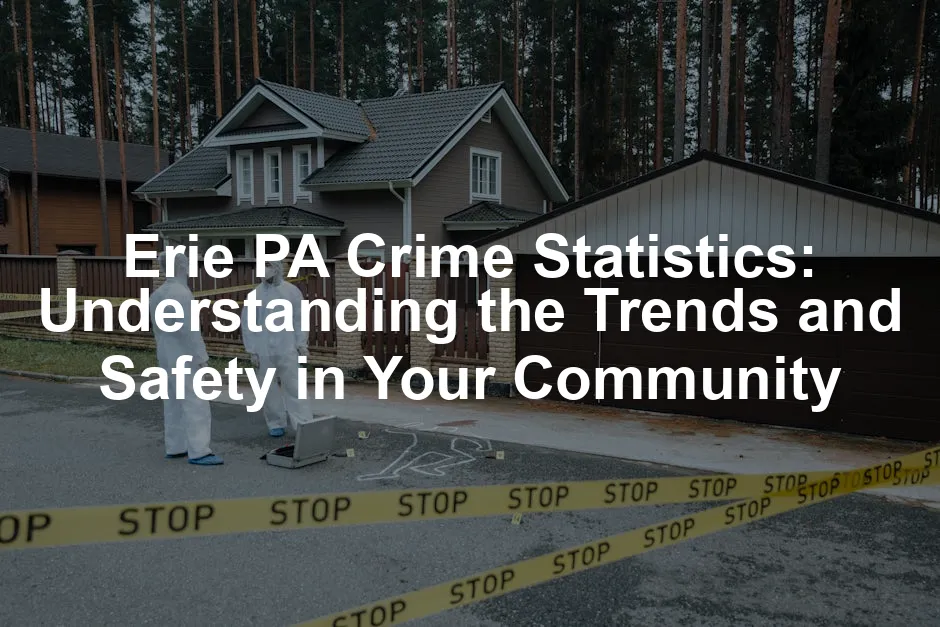Introduction
Welcome to Erie, Pennsylvania! Nestled along the shores of Lake Erie, this vibrant city boasts a rich history and charming neighborhoods. With a population of approximately 99,000, Erie is a key economic hub in Northwestern Pennsylvania. However, just like every community, it faces challenges, particularly concerning crime.
Understanding crime statistics is crucial for residents and potential movers. Why? Because knowledge is power. When you grasp the crime landscape in your area, you can make informed decisions about safety, community engagement, and even real estate. Whether you’re a long-time resident or considering a move, awareness of crime trends helps foster a safer environment.
This article aims to provide a comprehensive overview of crime statistics in Erie, PA. We’ll explore comparisons, trends, and community perceptions. By the end, you’ll have a clearer picture of what it means to live in Erie concerning safety and security.
Understanding these statistics isn’t just about numbers. It’s about connecting with your community. It’s about ensuring that Erie remains a place where families can thrive, businesses can grow, and everyone feels secure. So, let’s dig into the data and uncover the truths behind Erie’s crime statistics!

Understanding Crime Statistics
What Are Crime Statistics?
Crime statistics are essential for understanding the safety of a community. They provide a numerical snapshot of crime occurrences, helping residents gauge their environment. These statistics are typically compiled by law enforcement agencies and can cover various types of crime.
Crimes are categorized primarily into two groups: violent crimes and property crimes. Violent crimes include offenses like murder, robbery, and assault, which directly harm individuals. On the other hand, property crimes involve theft and vandalism, affecting personal belongings and property.
Understanding the difference between these crime types is vital. Violent crimes often evoke fear and urgency, while property crimes can lead to financial losses and a sense of insecurity. Both types, however, significantly impact community perceptions and quality of life.

Overview of Erie, PA Crime Rates
Currently, Erie has a crime rate of 29 crimes per 1,000 residents. This rate is notably higher than the national average, which raises eyebrows and questions about safety. Residents face a 1 in 35 chance of becoming a victim of either a violent or property crime.
When we break it down further, Erie’s violent crime rate stands at 6.13 per 1,000 residents, while property crimes hit 22.65 per 1,000 residents. To put this in perspective, Pennsylvania’s average for violent crime is 2.8 per 1,000, and for property crime, it’s 14.83 per 1,000. Nationally, the figures are 4 and 20 per 1,000, respectively.
This comparison highlights a concerning trend: Erie is grappling with higher crime rates than both state and national averages. Understanding these statistics is crucial for residents and those considering a move to Erie. It empowers them to engage with local initiatives aimed at improving safety and fostering a sense of community resilience.

Speaking of community resilience, enhancing personal safety is paramount. Consider investing in a Personal Safety Alarm Keychain. This handy gadget can provide peace of mind when you’re out and about, ensuring you’re prepared should you ever find yourself in a tight spot.
In summary, Erie is a community rich in culture and potential, but it also faces significant crime challenges. Understanding the nuances of crime statistics provides a clearer picture of what living in Erie means for safety and well-being.

Detailed Crime Statistics for Erie, PA
Violent Crime Statistics
In Erie, PA, violent crime is a pressing concern. The overall violent crime rate stands at 6.13 per 1,000 residents. This means that, statistically speaking, your chances of becoming a victim of a violent crime are approximately 1 in 163.
Breaking it down further, here’s the snapshot of specific violent crimes:
- Murder: 5 incidents
- Rape: 49 incidents
- Robbery: 86 incidents
- Assault: 433 incidents
These figures paint a vivid picture. The most prevalent violent crime in Erie is assault, which is no surprise given the city’s challenges. Over the past year, Erie has seen a significant increase in violent crime, with an uptick of 19.1%. This alarming trend raises eyebrows and emphasizes the need for community awareness and engagement.

Property Crime Statistics
When it comes to property crimes, Erie has a rate of 22.65 per 1,000 residents. This translates to a 1 in 44 chance of being a victim of property crime. The breakdown of property crimes is as follows:
- Burglary: 280 incidents
- Theft: 1,723 incidents
- Motor Vehicle Theft: 115 incidents
Just like the violent crime rates, property crime has also seen a rise, increasing by 16.4% year-over-year. Theft remains the most common property crime, and it’s a reminder to residents to be vigilant about securing their belongings.

Summary Table of Crime Data
To provide a clearer view of Erie’s crime statistics, here’s a concise table summarizing key data:
| Crime Type | Rate per 1,000 Residents | Total Incidents | Year-over-Year Change |
|---|---|---|---|
| Violent Crime | 6.13 | 573 | +19.1% |
| – Murder | 0.05 | 5 | +0% |
| – Rape | 0.49 | 49 | +0% |
| – Robbery | 0.86 | 86 | +0% |
| – Assault | 4.33 | 433 | +0% |
| Property Crime | 22.65 | 2,118 | +16.4% |
| – Burglary | 2.80 | 280 | +0% |
| – Theft | 17.23 | 1,723 | +0% |
| – Motor Vehicle Theft | 1.15 | 115 | +0% |
This table provides a clear overview of crime trends in Erie, highlighting the urgent need for community involvement and safety measures. Understanding these statistics is essential for residents and those contemplating a move to this city. It’s not just about numbers; it’s about fostering a safer environment for everyone.

Crime Comparison: Erie vs. Other Areas
Erie vs. Pennsylvania
When examining crime statistics, Erie, PA, stands out starkly against the backdrop of the state. With a violent crime rate of 6.13 per 1,000 residents, Erie is significantly higher than the Pennsylvania average of 2.8 per 1,000 residents. That’s right—Erie’s residents are more likely to face violent crime than the average Pennsylvanian.
Let’s talk property crimes. Erie’s rate sits at 22.65 per 1,000 residents, while the statewide average is 14.83 per 1,000 residents. That’s a notable difference! This suggests that Erie is not just a little more dangerous; it’s facing a crime wave that’s making the entire state raise an eyebrow.
The disparity in these figures paints a vivid picture of a city grappling with crime. While Pennsylvania enjoys an overall lower crime rate, Erie’s statistics serve as a reminder that safety can vary drastically within the state.

Erie vs. National Averages
Now, how does Erie fare when we zoom out and compare it to national statistics? Spoiler alert: not great. The national average for violent crime is 4 per 1,000 residents, meaning Erie isn’t just above average; it’s a few steps ahead in the wrong direction.
To break it down, Erie’s violent crime rate is 64% higher than the national average. This alarming statistic shows that locals are facing a higher risk of violent crimes like assaults and robberies.
On the property crime side, Erie’s 22.65 per 1,000 is also higher than the national average of 20 per 1,000 residents. This indicates that while many cities across the country are working toward reducing property crimes, Erie seems to be caught in a different game.

Nearby Cities Comparison
Let’s take a quick detour to see how Erie stacks up against its neighbors. Cities like Fairview and Waterford boast significantly lower crime rates, providing a stark contrast to Erie. For instance, Fairview has a violent crime rate of just 123 per 100,000 people, while Waterford stands at 126 per 100,000.
These nearby cities aren’t just numbers; they represent communities where residents enjoy a greater sense of security. It’s no wonder many Erie’s residents might feel a pang of envy when looking at their crime statistics.
In fact, this comparison can influence perceptions of safety. While Erie struggles with its crime issues, neighboring cities are shining examples of what can be achieved with community engagement and effective law enforcement strategies.
The statistics reveal a clear narrative: Erie is facing challenges that its neighboring cities have managed to avoid. Safety perceptions can significantly impact community morale, and the crime statistics illustrate why Erie residents might feel on edge.
As we can see, the crime comparison between Erie and other areas highlights a pressing need for community action and a re-evaluation of safety measures. Understanding these trends is vital for residents and those considering a move to Erie, as it emphasizes the importance of community engagement and fortifying local safety initiatives.

Community Perceptions and Safety Insights
Local Sentiment on Crime
Understanding community sentiment about crime is essential for gauging safety in Erie. A recent survey by AreaVibes captured the feelings of local residents. The results revealed a divided perspective on safety. According to the poll, only 30% of respondents felt secure, believing that crime was nearly non-existent in their neighborhoods. Meanwhile, a staggering 70% expressed apprehension, feeling uneasy about walking alone at night.
This disparity highlights a growing concern among residents. Many feel that crime is on the rise, impacting their day-to-day lives. The fear of becoming a victim can significantly affect community cohesion. When people feel unsafe, they may avoid going out, which can lead to a decline in local businesses and community events.
Clearly, the statistics paint a picture of a community grappling with safety concerns, making it imperative for local authorities to address these issues head-on. Fear can be contagious, and it’s crucial to transform these sentiments into proactive measures that improve security and restore confidence.

Community Initiatives and Law Enforcement
The Erie Police Department is actively working to combat crime through various initiatives. Mayor Joe Schember recently highlighted several programs designed to improve safety, reflecting a commitment to enhancing community security.
One noteworthy initiative is the COSSUP Program (Comprehensive Opioid, Stimulant, and Substance Use Site-based Program). This program identifies at-risk individuals and low-level offenders for diversion to support programs, addressing underlying issues that often lead to crime.
Additionally, the Crisis Car Initiative introduces specialized officers trained to handle mental health crises and domestic violence incidents. By focusing on these sensitive areas, law enforcement can mitigate potentially dangerous situations before they escalate.
The Erie Police Department is also implementing the ShotSpotter technology, which detects gunfire and improves response times. This technological advancement aims to deter violent crime and reassure residents that their safety is a top priority.
Community programs like neighborhood watch groups and crime prevention workshops further enhance safety. These initiatives foster collaboration between law enforcement and residents, creating a united front against crime. When citizens feel empowered to engage with their local police, it builds trust and enhances overall community safety.

Crime Mapping and Awareness
Crime mapping tools have become invaluable resources for Erie residents. These platforms allow individuals to visualize crime data in their neighborhoods. By using color-coded systems, residents can quickly identify areas with high or low crime rates. This awareness empowers them to make informed decisions about where to live or venture out.
For instance, knowing which neighborhoods have higher crime rates can help families and individuals choose safer areas. It can also inspire residents to take part in community safety initiatives. Awareness is the first step in making a difference—when people are informed, they can engage with local law enforcement and advocate for safer streets.
The importance of these tools cannot be overstated. They not only provide insight into crime patterns but also encourage community involvement. Residents can report suspicious activities and work together to foster a safer environment for everyone.
In conclusion, community perceptions of crime in Erie are shaped by various factors, including survey results and law enforcement initiatives. While many residents express concerns about safety, the efforts of the Erie Police Department and community engagement initiatives provide hope. By leveraging crime mapping tools and fostering collaboration, Erie’s residents can work toward building a safer and more united community.

Methodology of Crime Data Collection
Understanding how crime data is collected is crucial for evaluating its accuracy and relevance. The information we rely on comes from several trusted sources, including the FBI’s Uniform Crime Reporting (UCR) Program and local law enforcement agencies.
Data is compiled annually, reflecting reported incidents from thousands of law enforcement agencies across the country. This extensive network ensures a comprehensive view of crime trends in Erie and beyond. The Erie Police Department contributes its statistics, which are then analyzed and compared to national averages.
Moreover, the methodology behind these crime statistics emphasizes predictive accuracy. By employing advanced analytics and statistical models, agencies can identify trends, foresee potential crime spikes, and allocate resources effectively. This proactive approach enhances community safety and allows law enforcement to address emerging issues before they escalate.
Understanding the methodology behind crime data collection empowers residents. When individuals know where the data comes from and how it’s analyzed, they can participate in discussions about community safety more effectively. They can also hold local officials accountable for improving security measures based on these insights.
In summary, crime data collection in Erie is a meticulous process that involves collaboration between various agencies. By understanding this methodology, residents can better interpret crime statistics and engage more meaningfully in community safety discussions.

How Crime Data is Collected
Crime data in Erie, PA, is collected through a combination of sources to ensure accuracy and comprehensiveness. The primary source is the FBI’s Uniform Crime Reporting (UCR) Program, which aggregates data from local law enforcement agencies across the nation. In Erie, the Erie Police Department plays a crucial role in reporting incidents, ensuring that the statistics reflect the realities of the community.
These agencies compile data on various crime types, including violent crimes such as murder and assault, alongside property crimes like burglary and theft. This systematic approach allows for a standardized collection of information, making it easier to compare Erie’s crime rates to those of other cities.
The significance of the data’s predictive accuracy cannot be overstated. Accurate crime statistics help law enforcement and community leaders identify trends. For instance, if a spike in burglaries is noted in a particular area, resources can swiftly be allocated to address this issue. This proactive approach enhances community safety assessments, allowing residents to understand their environment better.
Understanding how crime data is collected fosters trust between the community and law enforcement. When residents know that their safety is being monitored and prioritized, they can feel more secure in their neighborhoods. Ultimately, this transparency is vital for community engagement and collaboration in crime prevention efforts.

FAQs
What are the most common crimes in Erie, PA?
In Erie, the most common crimes reported include theft, assault, and burglary. Theft accounts for a majority of property crimes, with 1,723 incidents reported last year. Assaults follow closely behind, with 433 incidents. Additionally, the city recorded 86 robberies and 5 homicides.
How does Erie compare to other cities in Pennsylvania regarding crime?
When compared to other cities in Pennsylvania, Erie has a higher crime rate than the state average. For instance, the violent crime rate in Erie is 6.13 per 1,000 residents versus Pennsylvania’s average of 2.8 per 1,000. In terms of property crime, Erie also exceeds the average, with 22.65 per 1,000 compared to the state average of 14.83 per 1,000.
What steps are being taken to improve safety in Erie?
Erie has implemented several initiatives aimed at improving community safety. The Erie Police Department has introduced the Crisis Car Initiative, which trains officers to handle mental health crises and domestic violence situations. Additionally, the COSSUP Program helps divert at-risk individuals from the criminal justice system into support programs. These efforts demonstrate a commitment to enhancing public safety and addressing crime proactively.
How can residents stay informed about crime in their neighborhood?
Residents can stay informed through various resources, including local crime mapping tools and community meetings. Websites like AreaVibes and NeighborhoodScout provide updated crime data and reports. Additionally, engaging with local law enforcement through neighborhood watch programs can foster a sense of community and safety.
What should I do if I become a victim of crime in Erie?
If you become a victim of crime in Erie, it’s crucial to report the incident to the Erie Police Department immediately. They can provide assistance and guide you through the reporting process. Local resources such as victim support services can also offer help, ensuring you have the support needed during a challenging time.
Please let us know what you think about our content by leaving a comment down below!
Thank you for reading till here 🙂 And remember, if you want to secure your home, consider a Home Security System with Camera. It’s a small price to pay for peace of mind!
For a deeper understanding of statistical methods, including the F-statistic, you can refer to this comprehensive guide to the F-statistic in the lmperm package for R.
All images from Pexels




